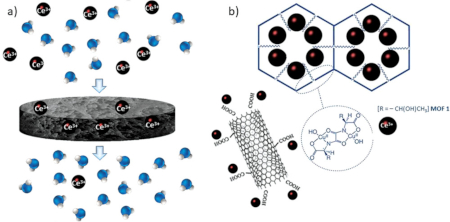Journal: Adv. Mater. Interfaces 2021, 8 2100730
Abstract: Human society is facing—among other environmental threats—an enormous challenge due to human activities. The extensive use of high-tech devices and electronics equipment in the daily life makes, among others, rare-earth elements (REEs) recovery from secondary sources highly required. Here, a novel bioMOF-based single-walled carbon nanotube buckypaper (SWCNTBP) is presented as a new and efficient composite material (BioMOF@SWCNT-BP). The flexible and highly crystalline metal–organic framework (MOF), prepared from the natural amino acid L-threonine, has been homogeneously dispersed within the tangled net of a self-standing SWCNT-BP for lanthanides recovery from water. This MOF-carbon-based membrane exhibits high efficiency, either in static or dynamic regimes, in the recovery of lanthanides from aqueous streams outperforming the state-of-the-art. The capture performances of BPs are successfully improved after incorporation of such MOF featuring hexagonal functional channels decorated with the threonine amino acid residues, pointing toward the accessible void spaces, which boosts the capture properties of the final membrane, providing the adaptable functional environment to interact with lanthanides. This material’s preparation presents also a potential for large-scale applications with a potential benefit on natural aquatic ecosystems as well. It is highly demanded because REEs from non-recycled waste materials are potential pollutants for surface waters.

